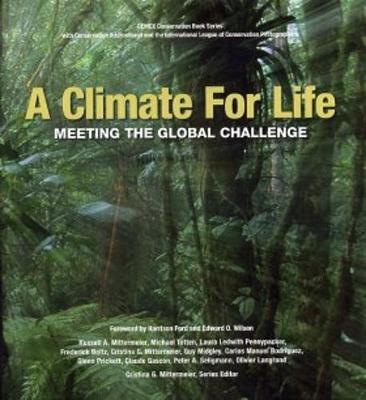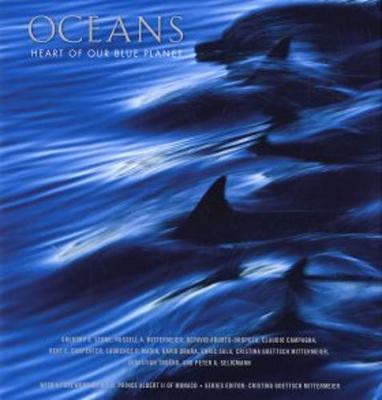CEMEX Conservation Book
3 primary works
Book 16
A Climate For Life
by Russell A. Mittermeier, M. Totten, L. L. Pennypacker, F. Boltz, C. G. Mittermeier, Glenn T. Prickett, Claude Gascon, and Peter A. Seligmann
Published 31 January 2008
This lavishly illustrated book focuses on the global challenge of climate change and what we can do now and in the coming decades to dramatically reduce risks to human health, economic prosperity, and the planet's irreplaceable biodiversity. In particular, it looks at the threats to biodiversity and human survival, the abundance of nature-based and technological solutions now available, and the need for rapid and continuous action on all fronts. With a comprehensive introduction written by a distinguished group of scientists led by Russell A. Mittermeier, President of Conservation International, and a foreword by Harrison Ford and Edward O. Wilson, A Climate for Life focuses on some of the most important challenges facing life on our planet.A Climate for Life provides a message that places the risk of climate destabilization by humans in context by clarifying how its causes, impacts, and solutions derive from the intricate and delicate balance between modern society and the natural world. The expert authors examine a wide range of climate issues, with particular emphasis on how natural environments can contribute to and benefit from measures to address climate change, while the world-renowned photographers provide breathtaking evidence for the urgency of our cause.Ten chapters cover the foremost climate issues, including how the world's forests, important as carbon sinks, are being rapidly deforested; how both avoided deforestation and reforestation are key actions for stabilizing the global climate; how areas of threatened biodiversity are adapting to climate change, some more successfully than others; what role our oceans play as climate change raises temperatures globally; the impact on freshwater systems; what happens globally as polar areas warm and melt; and how humans face mounting risks from an overheated atmosphere, particularly in developing countries.And yet there is considerable hope. Incredible technological innovations are moving us towards zero net energy buildings, zero emission cars and factories, global-scale harnessing of competitive wind and solar power and other renewable energy options, thus reducing our dependence on fossil fuels. These reductions, in conjunction with strategies to prevent deforestation and land degradation, offer economically and ecologically attractive means of stabilizing the Earth's climate. Conservation efforts will buffer protected areas and ensure that habitats are preserved and species can migrate to adapt, and developing countries will be able to ensure sustainable livelihoods for their citizens without jeopardizing their most precious resources.Powerfully illustrated with 175 photographs by some of the world's foremost photographers, the book graphically illustrates the concepts in each chapter. Additionally, ten photographers are featured as "Eyewitnesses to Change." Their firsthand experiences in the field are documented through a portfolio of their images and firsthand account of their experiences. The list of noted photographers includes Frans Lanting, James Balog, and Joel Sartore, among others.We have the capacity to destroy or to safeguard the biodiversity on our planet. It is within our grasp to adapt to the conditions we have created and to mitigate our impact on the future. Now is the time to engage our intellect, develop solutions, and implement the actions needed to ensure a stable climate for the future - A Climate For Life.
Book 18
Fresh Water: The Essence of Life
by Russell A. Mittermeier, Tracy A. Farrell, Ian J. Harrison, Amy J. Upgren, and Thomas M. Brooks
Published 31 December 2010
Fresh Water: The Essence of Life is a beautifully and sometimes starkly depicted look at the current state of our Earth's freshwater ecosystems. A variety of authors, as well as dozens of the world's most accomplished photographers, tells us a story we may feel uncomfortable hearing: The Earth's freshwater supply and systems are in serious peril. We may carry on as if it was "business as usual," but to do so is at our own risk - and will lead certainly to the detriment of the generations to follow us.This latest publication in the CEMEX Conservation Book Series will alert readers to key issues concerning fresh water: its resources, its uses (and abuses), and its future. With precise, scientific analyses, Fresh Water: The Essence of Life presents a detailed and thoughtful explanation of these issues, and goes on to provide possible resolutions to them. As in The Wealth of Nature, CEMEX's most recent publication, Fresh Water makes a statement concerning the Earth's resources and capital: although the ecosystems have proved resilient throughout millennia, in the last few generations humanity has radically destroyed fresh water ecosystems to the point of alarm.Through the pages of this volume, the reader will be challenged to not only understand the significance of deteriorating fresh waters, but will also be motivated to rally support in political, biogeographical, and conservation forums.Series editor Cristina Mittermeier has once again successfully gathered distinguished authors from a range of disciplines. Beginning with a Foreword by Luc Hoffmann, founder of the MAVA Foundation and led by Dr. Russell A. Mittermeier (President of Conservation lnternational) along with contributions from some of the most knowledgeable freshwater biologists and scientists in the field today, including Thomas Brooks (Nature Serve), Tracy Farrell (Conservation International), Ian Harrison (Conservation lnternational), and Amy Upgren (Conservation International) have specialized in developing national regulations for freshwater systems, species taxonomy and data compilation, wildlife trade, research and development, ornithology, biodiversity, and conservation actions.The authors have contributed chapters important to understanding the issues; from exploring and applauding the groundbreaking 1971 Ramsar Convention on Wetlands, to Conservation International freshwater initiative, their varied backgrounds provide a breadth of knowledge in covering such topics as aquatic ecosystems, threats to such ecosystems, the services provided by freshwater ecosystems, its protected areas, and the future of not only freshwaters, but of their relation to humanity and the generations to come.It is within our grasp to adapt to the conditions we have created and to mitigate our impact on the future, but the window of opportunity is closing. Now is the time to reclaim our humility in relationship to the Earth's fresh water and to resurrect an understanding of how interdependent we are with these ecosystems.
Book 19
Oceans: Heart of Our Blue Planet
by Gregory S Stone, Russell A. Mittermeier, Octavio Aburto-Oropeza, Claudio Campagna, Kent E. Carpenter, Laurence P. Madin, David Obura, Enric Sala, and Sebastian Troeng
Published 31 December 2011
Water makes life on Earth possible, and every drop of it comes from and returns to the ocean. For centuries we have taken the ocean for granted, viewed it as inexhaustible, unknowable; a vast, briny, deep mystery. Oceans: Heart of Our Blue Planet, the 19th volume in the CEMEX Conservation Book Series, looks at the many ways in which all life on Earth depends on a healthy ocean and analyzes the many threats facing its integrity and the welfare of the thousands of people and species that live in and near marine environments. More importantly, this lavishly illustrated book helps connect the dots for why human survival on Earth is directly linked to the ocean and offers innovative and creative solutions to those threats by some of the most respected and forward-thinking marine scientists.Humankind ventured forth upon the sea in boats, at first tentatively hugging the shoreline but eventually venturing across long distances of open water to colonize the whole planet. As we learn more about our planet's oceans and their enormous influence on climate, freshwater cycling, food security and human health, we will be better prepared to create policies that protect ocean landscapes and services that are critical to human societies.With a moving foreword written by HSH Prince Albert of Monaco, Oceans: Heart of Our Blue Planet, includes 7 chapters by influential marine scientists lead by Dr. Greg Stone and Dr. Russell A. Mittermeier of Conservation International. The authors, who represent some of the world's most prestigious ocean conservation and research institutions, including The New England Aquarium, Scripps Institution of Oceanography, Woods Hole Oceanographic Institution, National Geographic, Old Dominion University, Wildlife Conservation Society, Coastal Oceans Research and Development in the Indian Ocean, and Code Blue present a comprehensive picture of what is happening to our world's oceans. They go a step further to identify specific seascapes where the ground is being laid for policy and management practices that will ensure better marine governance among the various countries that have sovereign rights to those marine resources.Powerfully illustrated with over 150 photographs by some of the world's leading conservation photographers, Oceans: Heart of Our Blue Planet, is a pictorial call to action on one of today's most pressing conservation challenges. How we move forward to protect the ocean, its resources and the myriad of ecological services it provides for all humanity, within large part will determine how successful we are in securing an environmentally sound future for generations to come.


